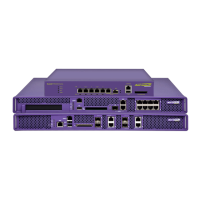Summit WM3000 Series Controller System Reference Guide 25
1 When a new AP is adopted, it scans each channel. However, the controller does not forward traffic at
this time.
2 The controller then selects the least crowded channel based on the noise and traffic detected on each
channel.
3 The algorithm used is a simplified maximum entropy algorithm for each radio, where the signal
strength from adjoining AP's/MU's associated to adjoining AP's is minimized.
4 The algorithm ensures adjoining AP's are as far away from each other as possible (in terms of
channel assignment).
Individual radios can be configured to perform automatic channel selection.
WMM-UPSD
This feature is also known as WMM Power Save or WMM-UPSD. WMM-UPSD defines an unscheduled
service period, which are contiguous periods of time during which the controller is expected to be
awake. If the controller establishes a downlink flow and specifies UPSD power management, it requests
(and the AP delivers) buffered frames associated with that flow during an unscheduled service period.
The controller initiates an unscheduled service period by transmitting a trigger frame. A trigger frame is
defined as a data frame (e.g. an uplink voice frame) associated with an uplink flow with UPSD enabled.
After the AP acknowledges the trigger frame, it transmits the frames in its UPSD power save buffer
addressed to the triggering controller.
UPSD is well suited to support bi-directional frame exchanges between a voice STA and its AP.
Dynamic VLAN Support
There are four packet flows supported when the controller is configured to operate with multiple VLAN
per WLAN:
● Unicast From Mobile Unit - Frames are decrypted, converted from 802.11 to 802.3 and switched to the
wired side of the VLAN dynamically assigned to the mobile device. If the destination is another
mobile device on the wireless side, the frame is encrypted and switched over the air.
● Unicast To Mobile Unit - The frame is checked to ensure the VLAN is same as that assigned to the
mobile device. It is then converted to an 802.11 frame, encrypted, and sent over the air.
● Multicast/Broadcast From Mobile Unit - The frame is treated as a unicast frame from the MU, with the
exception that it is encrypted with the per-VLAN broadcast key and then transmitted over the air.
● Multicast/Broadcast from Wired Side - If the frame comes from a VLAN mapped to the WLAN, it’s
encrypted using a per-VLAN broadcast key and transmitted over the air. Only MUs on that VLAN
have a broadcast key that can decrypt this frame. Other MUs receive it, but discard it.
In general, when there are multiple VLANs mapped to the same WLAN, the broadcast buffer queue
size scales linearly to accommodate a potential increase in the broadcast packet stream.
Roaming within the Controller
When a MU is assigned to a VLAN, the controller registers the VLAN assignment in its credential
cache. If the MU roams, it is assigned back to its earlier assigned VLAN. The cache is flushed upon
detected MU inactivity or if the MU associates over a different WLAN (on the same controller).

